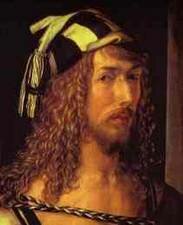 Albrecht Durer21.05.1471 N?rnberg - 06.04.1528 N?rnberg Art history: RenaissanceCanvases of Albrecht Durer [94 canvases]Short information:The central figure in the German Renaissance was Albrecht D?rer, a painter and graphic artist, one of the most outstanding personalities in the history of art. Biography of Albrecht DurerAlbrecht D?rer was born on 21 May, 1471 in Nuremberg, south Germany, son of a prosperous goldsmith Albrecht D?rer the Elder (1427-1502), and Barbara Holper. His early training was in drawing, woodcutting and printing, which were to remain his main and favorite media throughout his artistic career. 1486 through 1489 he was apprenticed in the workshop of Nuremberg artist Michael Wolgemut. He traveled much. In 1490 he left his native city for four year, probably initially visiting Cologne and possibly the Netherlands. He traveled to Italy twice in 1494-95 and 1505-07, visited Venice and Bologna, perhaps Florence and Rome. His fame was broadcasted through his engravings, and artists in Italy were soon drawing on them for ideas. In Venice he knew and admired above all the aged Giovanni Bellini. In 1495 he established his own workshop in Nuremberg. His best known works are his 18 engravings of the Apocalypse cycle, the most interesting of which is The Four Horsemen of the Apocalypse (1498). One of his patrons was the Frederick the Wise, Elector of Saxony from 1496, whose portrait he painted in 1496. He commissioned D?rer to paint several altarpieces: The Seven Sorrows of the Virgin (c.1496-1497), The Jabach Altarpiece (c.1503-1504), The Martyrdom of the Ten Thousand (1508) and The Adoration of the Magi (1504), which is considered to be one of the D?rer's masterpieces. D?rer's other patrons for religious works were wealthy Nuremberg citizens, who commissioned the following pieces: Lot Fleeing with His Daughters from Sodom (c.1498), The Paumgartner Altarpiece (c.1498-1504), Lamentation for Christ (c.1500-1503), The Adoration of the Holy Trinity (1511). D?rer was also known for his portraits, which were frequently commissioned from him. Among his best are Portrait of D?rer's Father at 70 (1497), Portrait of Oswolt Krel (1499), Portrait of Bernard von Reesen (1521), Portrait of Hieronymus Holzschuher (1526). He also painted several self-portraits, which give us the greatest insight into his character and beliefs: Self-Portrait at 22 (1493), Self-Portrait at 26 (1498) and Self-Portrait at 28 (1500). Throughout his life D?rer produced a lot of watercolour landscapes and nature studies, the best are Saint John's Church (1489), House by a Pond (1496), Willow Mill (1496-1498), A Young Hare (1502), The Large Turf (1503). D?rer's greatest achievement in printmaking were the three engravings of 1513-1514, regarded as his masterpieces Knight, Death and the Devil (1513), St. Jerome in His Study (1514) and Melencolia I (1514). After completing these engravings D?rer worked for the Emperor Maximilian , who commissioned him to design a huge print The Triumphal Arch, to celebrate the Emperor's achievements. This monumental project, composed of 192 woodblocks and 330 cm (11') high, is still the largest woodcut print ever made. In 1515 Emperor Maximilian granted him a pension of 100 florins, although it was stopped after his death in 1519. D?rer had to travel to the Netherlands in 1520-1521 to the court of the Emperor Charles V to have the pension confirmed. During his journey he met many famous Netherlands painters such as Quentin Massys, Joos van Cleve, Lucys van Leyden and others. In Antwerp he met Erasmus, the humanist scholar, and sketched his portrait. D?rer became an early and enthusiastic follower of Martin Luther. His new faith can be sensed in the growing austerity of style and subject in his religious works after 1520. The climax of this trend is represented by The Four Holy Men (1526). Albrecht D?rer is akin to Leonardo in his restless intellectual curiosity. He wrote and published theoretical works: Manual of Measurement (1525); Various Instructions for the Fortification of Towns, Castles and other Localities (1527). D?rer died on 6 April 1528 in Nuremberg and was buried in St. John’s churchyard. His Four Books on Human Proportion were published in October. D?rer is the most universal, the most balanced and the greatest of all German artists of any period.
You can find canvases of this artist in these museums:
|
Для красивого отображения Облака Quick Search artists |
|||||||||||||||